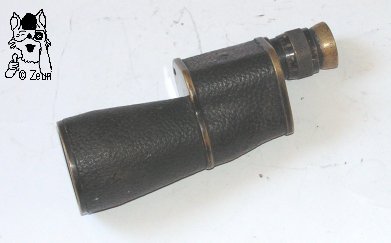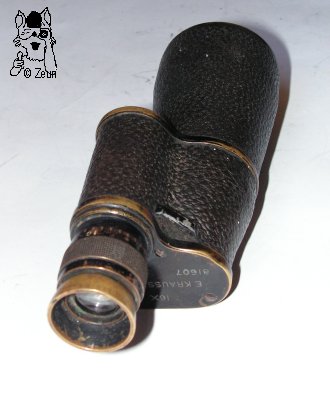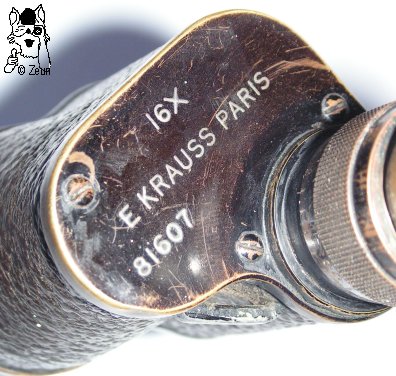E. Krauss 16x40
| Recht ähnlich, wenn auch nicht gleich, ist das Krauss 16x40 dem Carl Zeiss 16x40 Telextinmo. Zwar ist die Bauhöhe (Objektiv bis oberer Deckel) fast identisch, jedoch ist der Objektivtubus desKrauss länger, somit as Prismengehäuse kürzer. Das 16x40 ist am oberen dreifach verschraubten Messing-Deckel mit "16x E. Krauss Paris 81607" beschriftet. Das Gehäuse hat eine dunkelbraune Hartgummi-Ummantelung mit Lederstrukturierung. Das rechtsseitige Okular hat eine komplett umlaufende Dioptrienskala mit Markierungen bei +10 bis -10. Die Messingaugenmuschel könnte ein nachträglicher Ersatz für ein Origignal aus Bakelit sein. |
The Krauss 16x40 is quite similar but still not the same as the Carl Zeiss 16x40 Telextinmo. Though the height (objectie to top cover plate) is almost the same, the Krauss has a longer objective tube and thus a shorter prism housing. The 16x40 is marked "16x E. Krauss Paris 81607" at the black painted brass top cover having three screws. The housing is covered with leather textured dark brown ebonite. The right-hand sided ocular has a full dioptre scale marked from +10 to -10. The brass eyecup might be a substitute for an original Bakelite one. |





| Das 16x40 ist 154-158mm lang, am 53mm hohen Gehäuse oben 51x51mm und unten 57x57mm breit. Der 71mm lange konische Objektivtubus ist am Anfang 41mm und am Ende 51mm im Durchmesser. Das Okular ist 24mm, der Fokussierungsring und die Augenmuschel sind 27mm im Durchmesser. Das Monokular ist 385g schwer. | The 16x40 is 154-158mm in length. The 53mm tall housing measures 51x51mm at its top and 57x57mm at its bottom. The 71mm long conical objective tube is 41mm in diameter a the start and 51mm in diameter at its end. The eyepiece is 24mm, the focusing ring and the eyecup are 27mm in diameter. The monocular weighs 385g. |
Fotos: Zeun

